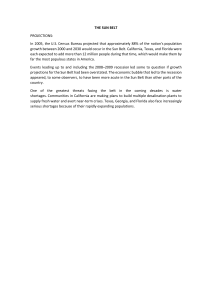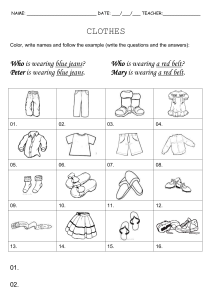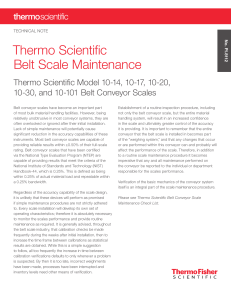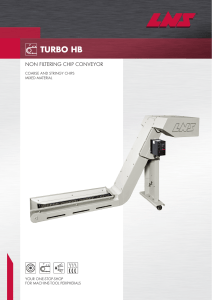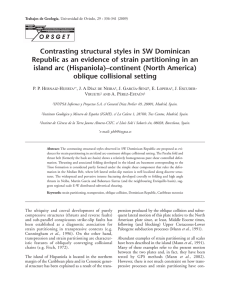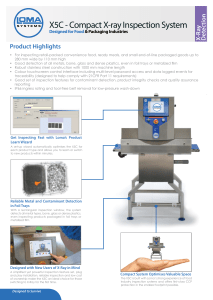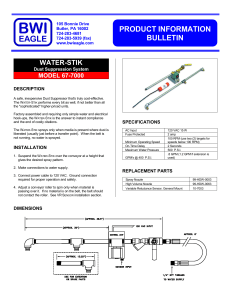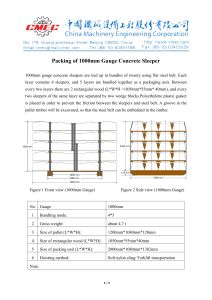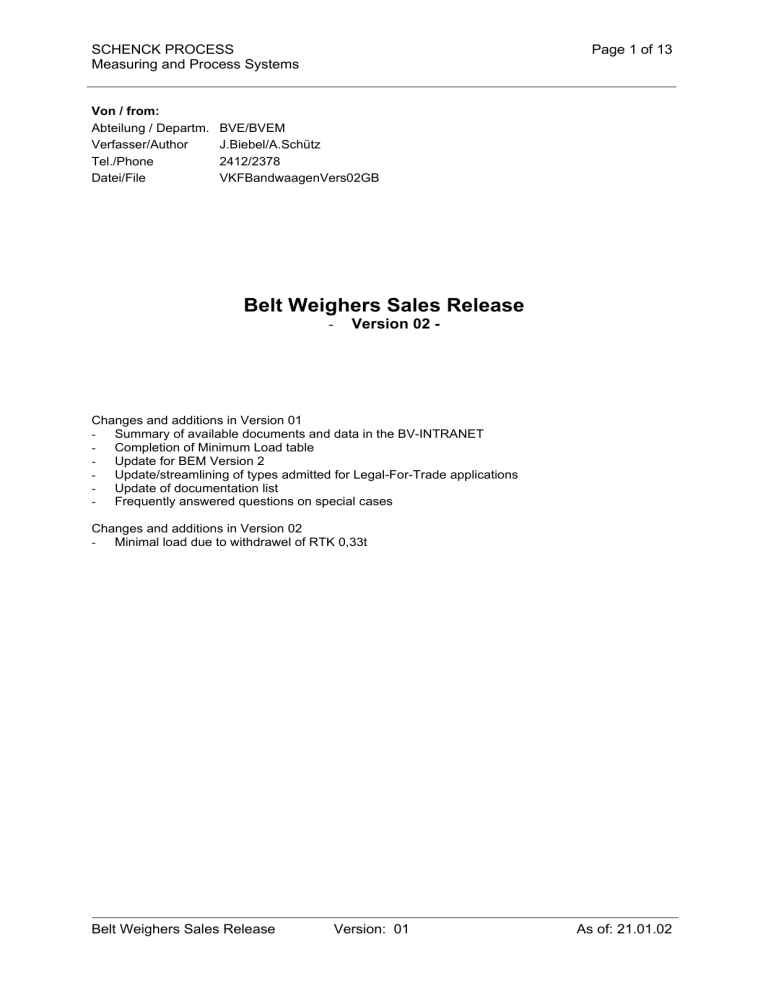
SCHENCK PROCESS Measuring and Process Systems Von / from: Abteilung / Departm. Verfasser/Author Tel./Phone Datei/File Page 1 of 13 BVE/BVEM J.Biebel/A.Schütz 2412/2378 VKFBandwaagenVers02GB Belt Weighers Sales Release - Version 02 - Changes and additions in Version 01 - Summary of available documents and data in the BV-INTRANET - Completion of Minimum Load table - Update for BEM Version 2 - Update/streamlining of types admitted for Legal-For-Trade applications - Update of documentation list - Frequently answered questions on special cases Changes and additions in Version 02 - Minimal load due to withdrawel of RTK 0,33t Belt Weighers Sales Release Version: 01 As of: 21.01.02 SCHENCK PROCESS Measuring and Process Systems Page 2 of 13 Table of Contents 1. General Information ..........................................................................................................................2 2. Overview ...........................................................................................................................................3 3. Characteristics and Requirements....................................................................................................4 3.1 General Characteristics and Requirements ...................................................................................4 3.1.1 Installation Prerequisites..........................................................................................................4 3.1.2 Accuracies and Dimensions ....................................................................................................5 3.1.2.1 Accuracy Class Table ...........................................................................................................5 3.1.2.2 Minimum Belt Load Table .....................................................................................................6 3.1.3 Speed Measurement ...............................................................................................................7 3.1.3.1 Speed Transducer Table ......................................................................................................7 3.1.4 Belt Length Measurement........................................................................................................7 3.1.5 Weighing Electronics ...............................................................................................................8 3.1.5.1 Weighing Electronics Table ..................................................................................................8 3.2 Special Features of the BEM series ...............................................................................................8 3.3 Special Features of the BEP/BED series .......................................................................................9 3.4 Special Features of the BMP series ...............................................................................................9 3.5 Special Features of the BMC series...............................................................................................9 3.6 Special Features of Belt Weighers Type BMK (not released for sale).........................................10 3.7 Special Features of Belt Weighers with DWS Transducers (not released for sale).....................10 4. Special Cases .................................................................................................................................10 4.1 Legal-For-Trade Applications .......................................................................................................10 4.2 Movable Conveyors......................................................................................................................11 4.3 Surface Protection........................................................................................................................11 Type ................................................................................................................................................11 4.4 Weigh Belts ..................................................................................................................................12 4.5 Closed Belt Systems ....................................................................................................................12 4.6 Test Weight ..................................................................................................................................12 4.7 Chain Calibration ..........................................................................................................................12 4.8 Explosion Protection.....................................................................................................................12 4.9 Lightning Arresters .......................................................................................................................12 4.10 Conversions................................................................................................................................13 5. Documents and Utilities ..................................................................................................................13 5.1 Documents Table (Extract) .......................................................................................................13 1. General Information The present sales release applies to all belt weigher types offered by SCHENCK PROCESS. Comparing their strengths and functionalities, this paper helps select the right type and offers arguments against competitive systems. The belt weighers are registered under the MULTIBELT trademark. Belt weighers are components designed for installation in user's conveyor belts. The target group are resellers and final customers. The preferred sales channel is the component business. Systems and documentation are designed so that the user can install and commission his belt weigher single-handedly. However, professional skills and stringent care are required to provide the appropriate environment. We have to assume that most customers fail to see the correlation between proper mounting and accuracy. Therefore, inspection and commissioning through a SCHENCK service engineer should be urgently recommended. Belt Weighers Sales Release Version: 01 As of: 21.01.02 SCHENCK PROCESS Measuring and Process Systems Page 3 of 13 2. Overview Operating principle Weigh span SCHENCK series Field of application 2 Weigh stations on the stringers Single idlers BEM - Belt conveyors Strengths - Weigh Single idlers BEP station inside BED belt stringers - Weigh Multi idlers station inside belt stringers - BMP Belt conveyors - Belt conveyors - Platform Multi idlers BMC - Belt conveyors Rail-based 2) conveyors - Buckled platform Multi idlers BMK No longer released for sales - Belt conveyors Rail-based 2) conveyors - Rails Multi idlers Not released for sales Rail-based 2) conveyors - 1) 2) 3) 4) Easy integration into user's 1) belt stringers Components independent of width Easy integration into user's 1) belt stringers Insensitive to crosswise belt stringer instabilities Easy integration into user's 1) belt stringers Insensitive to crosswise belt stringer instabilities Extended weigh span Large weigh spans and belt widths possible High loads possible Insensitive to vibration 3) excitation Insensitive to crosswise belt stringer instabilities Low requirements on transition 4) to weighing platform Large weigh spans and belt widths possible Insensitive to crosswise belt stringer instabilities Simple conveyor design Low headroom Insensitive to crosswise belt stringer instabilities No moving parts Integrated transition from stationary to weighed section No disruption of belt stringers required Here: troughed belt and apron conveyors High mass, low natural frequency Relevant only for rail-based conveyors Belt Weighers Sales Release Version: 01 As of: 21.01.02 SCHENCK PROCESS Measuring and Process Systems Page 4 of 13 3. Characteristics and Requirements 3.1 General Characteristics and Requirements 3.1.1 Installation Prerequisites There are some fundamental rules regarding configuration and installation to achieve a proper functioning. For warranty reasons, these are included in detail in the Belt Weigher documentation. It is strongly recommended to attach the Planning-in Hints F 9151 to the first quotation. The rules are usually dedicated to the so called Influantial Zone; this range consists of the Measuring Distance (Weigh Bridge) and the Inflantial Distance (3 idlers before and after the Weigh Bridge). The optimal prerequisites for a precise Belt Weigher are: - Mounting site No curves in influential zone No slope changes in influential zone Safety space between influential zone and troughing site (min. 2 carrying idlers) - Alignment Alignment of influential zone <0.2mm (including carrying idlers' out-of-round) Keeping of alignment under load, temperature and vibration - Construction Weight-based gravity take-ups No garland belts, no V-troughing Belt troughing max. 30°; for classes 4 to 7, max. 20° (see 3.1.2) Constant troughing in entire influential zone Rigid belt stringers (see Alignment), e.g. through welded joints, grouted supports No relative movement between bulk material and belt Maximum inclination depending on material; with smooth belts, maximum 20° Settling time after material feed depending on belt speed Protection of weigh span from atmospheric influences (wind, humidity, solar radiation) Vibrations outside of the measuring frequency Continuous and limited prefeeder (no overload at all at any time) Belt Weighers Sales Release Version: 01 As of: 21.01.02 SCHENCK PROCESS Measuring and Process Systems Page 5 of 13 3.1.2 Accuracies and Dimensions The combination of load cells and constructional principles results in a high number of partly overlapping accuracy classes. To obtain unique limitation and argumentation, only the combinations shown in Table 3.1.2.1 are released. The accuracy values stated in the table below assume that the belt weighers are properly mounted and operated and that the minimum belt loads indicated in Table 3.1.2.2 are complied with. The minimum belt loads also assume proper installation and operation. 3.1.2.1 Accuracy Class Table Class Accuracy 1 +/- 1 % related to nominal feed rate at 20 % - 100 % IN in accordance with BV-D 2105 AA and vbelt = const (without speed measurement) 2 +/- 1 % related to nominal feed rate at 20 % - 100 % IN in accordance with BV-D 2105 AA 3 +/- 0.5 % related to nominal feed rate at 20 % - 100 % IN in accordance with BV-D 2105 AA 4 +/- 0.25 % related to nominal feed rate at 20 % - 100 % IN in accordance with BV-D 2105 AA 5 +/- 1 % related to actual feed rate at 20 % - 100 % IN in accordance with BV-D 2105 AA 6 +/- 0.5 % related to actual feed rate at 20 % - 100 % IN in accordance with BV-D 2105 AA 7 +/- 0.25 % related to actual feed rate at 30 % - 100 % IN in accordance with BV-D 2105 AA 1) Mechanics type BEM Load cell type PWS (VBB) BEM BEP BED BEP BED PWS (VBB) 1) PWS RT 1) PWS RT BMP RT BEP BED RT RT BMP BMC RT RT 2 x BMP BMC RT RT up to 700 kg rated capacity Accuracies and minimum belt loads are based on mechanical scale properties as well as on load cell characteristics (temperature behaviour). It is assumed that the belt weigher performs a zero set at least after every 5K temperature change which corresponds to the hourly temperature change normally assumed in technical calculations. This is supported by the fact that the SCHENCK weighing electronics can be configured for automatic identification of empty belt with immediate start of the zero setting operation. For zero set, the belt feed has to be interrupted for more than two circuits. If the application does not allow the scale to be tared during operation (e.g. clinker weighing downstream of rotary kilns, measuring points downstream of reactors), higher minimum loads are required or reduced accuracies must be specified (in consultation with Mechanical Engineering or R & D). Belt Weighers Sales Release Version: 01 As of: 21.01.02 SCHENCK PROCESS Measuring and Process Systems Page 6 of 13 3.1.2.2 Minimum Belt Load Table This table shows the Minimum Belt Loads calculated with the given Preload and a minimum possible Rated Capacity of the load cell under which the Belt Weigher achieve the specified accuracy; this sets the lower end of the measuring range. If Load Cells with higher capacities are needed, the Minimum Belt Load increases. Please use for more detailed dimensioning the tool TECHDAT on the BV-INET. The Belt Weigher Type BMC has always to be calculated with TECHDAT. Class Accuracy [%] 1, 2 1 3 0.5 4 0.25 5 1 6 0.5 7 0.25 Related to Full scale PWS RT 3.5 3.6 3.7 4.0 8.8 9.2 9.4 4.3 4.5 4.8 8.6 9.4 9.8 10.1 2.7 2.8 2.9 Full scale PWS RT Full scale RT Actual value RT Actual value RT Actual value RT Load cell BEM (400) BEM (500) BEM (600) BEM (800) BEM (1000) BEM (1200) BEM (1400) BEP 04 BEP 05 BEP 06 BEP 08 BEP 10 BEP 12 BEP 14 BED 16 BED 18 BED 20 BMP 05 BMP 06 BMP 08 BMP 10 BMP 12 BMP 14 8.8 9.3 9.8 17.6 19.3 20.0 20.7 5.5 5.7 5.8 PWS 120 120 120 120 300 300 300 150 150 150 300 300 300 300 9,1 9,3 9,5 9,8 10,5 10,8 11,1 13,9 14,3 14,7 8,8 9,1 9,5 10,7 11,3 15,0 Load cell rated capacity 17.4 18.3 19.3 27.3 29.0 38.3 36.4 38.2 40.3 57.1 60.5 80.0 Scale preload (typ.) RT 470 470 470 470 470 470 470 660 660 660 470 470 470 470 470 680 31 34 41 51 79 95 106 35 45 55 70 105 120 135 105 125 142 130 150 175 245 285 325 All data in kg Belt Weighers Sales Release Version: 01 As of: 21.01.02 SCHENCK PROCESS Measuring and Process Systems Page 7 of 13 3.1.3 Speed Measurement Speed measurement is preferably performed free from slip with the use of transducers with friction wheels mounted on return belt. The transducer can also be mounted on a tail pulley. Normally, measurement is not totally free from slip, however, the slip is within acceptable tolerances (<0.2%). This equally applies if the speed transducer is mounted on drive motor. 3.1.3.1 Speed Transducer Table Type FGA 20 RSLE FGA 20 RSLE/VA FGA 20 RSLE/VA E FGA 24 Design Friction wheel, galvanised, 1 transducer Friction wheel , stainless steel, 1 transducer Friction wheel , stainless steel, 2 transducers, legal-for-trade Perforated disc for fixation on shaft Mounted on Belt stringers Resolution 20 imp/rev. Max. belt speed 3.5 m/s Belt stringers 20 imp/rev. 3.5 m/s Belt stringers 20 imp/rev. 3.5 m/s Tail pulley 24 imp/rev. Limited through limit frequency, transducer and weighing electronics The maximum belt speed is given from the speed where under sufficient belt tracking a slip free operation is given means the fricition wheel keeps permanently in contact with the belt. With improved belt tracking the maximum achievable maximum speed can be higher, with poor belt tracking the said maximum speed is possibly not achievable. For speeds > 3,5 m/sek the speed pick up should be mounted to the pulley shaft (FGA 24). The minum belt speed is theoretically only restricted by the minimum input frequency of the controller. SCHENCK controllers have a very low input frequency (e.g. INTECONT 0,04 Hz). Due to practical reasons (display speed, monitoring speed) we recommend not to use the entire band and to stay always with speeds higher than 0,05 m/sek. On principle, speed measurement can be dispensed with since the scale is calibrated for medium speed. With the usual sizing of belt drives, an additional measuring error of approx. +-2% must be considered. To be correct, this arrangement should be called "Belt Load Measuring System". 3.1.4 Belt Length Measurement All types of SCHENCK weighing electronics support belt length measurement by evaluation via proximity switches and a corresponding mark on belt. However, this type of measurement is not absolutely required since the length manually entered during calibration normally suffices in actual practice. With troughed belts, the drift needs not be measured; therefore, location and design of belt mark can be selected at will, a simple rivet is sufficient. For details, see "FAQs on Belt Mark " in the INTRANET. Belt Weighers Sales Release Version: 01 As of: 21.01.02 SCHENCK PROCESS Measuring and Process Systems Page 8 of 13 3.1.5 Weighing Electronics The table below shows the weighing electronics suitable for belt weighers, complete with most important arguments. For details, see relevant Release documents and manuals. 3.1.5.1 Weighing Electronics Table Series ECOCONT Design Mounting (mounting rail TS35) Strengths Commissioning via PC or integrated control panel Automatic zero set Pulse output Analog output INTECONT PLUS Panel-mounting unit (Option Wall mounted enclosure) - DISOCONT Mounting (screwed connection) (Option Field enclosure) - Convenient display and control panel Automatic zero set Coupling via serial interface or Modbus Pulse output Analog output Output for report printer Batch control Integrated feed control (option) Legal-for-trade (option) Commissioning via PC or integrated control panel (option) Automatic zero set Modularly expandable Coupling via industrial fieldbuses (option) Batch control Integrated feed control, optionally with differential value formation (option) 3.2 Special Features of the BEM series The BEM series Version 1 (aluminium sections) uses folded shear beams of the VBB type. The BEM series Version 2 (steel sections) uses platform load cells of the PWS type. Changeover to the new version starts in January 2002 (a pilot order has already been equipped in 2001). The changeover from Version 1 to Version 2 changes the rated capacity steps to 120kg (=2 x 60kg), 300kg (=2 x 150kg) and 600kg (=2 x 300kg). We recommend to use BEM up 1.400 maximum width. Belt Weighers for 1.600, 1.800 and 2.000mm have to be checked by the design department. The belt tensioning forces are absorbed by leaf-spring parallel guidances. The outboard measuring stations make installation and maintenance specially convenient. With version 2 the basic version is supported on the DIN stringers by means of angles. An installation aid (clamping plate to be welded on after alignment) is available as option. The scale is not suited for use in tubular frameworks. Serial connection for extension of weigh stations is possible but not necessarily economical. The maximum number of load cells as a function of weighing electronics must be observed (max. 4). The components are available as stock items. Belt Weighers Sales Release Version: 01 As of: 21.01.02 SCHENCK PROCESS Measuring and Process Systems Page 9 of 13 3.3 Special Features of the BEP/BED series The BEP series uses platform load cells of the PWS type up to 700kg rated capacity. With higher rated capacities, axisymmetrical load cells of the RTN type are employed. The belt tensioning forces are absorbed by leaf-spring parallel guidances. The design does not change the appearance of the belt stringers. The components are available as stock items. The BED contains to two measuring stations of the BEP type for the BED variant and is suitable for belt widths from 1.600mm up to 2.000mm. Owing to the high side forces, axisymmetrical load cells are normally used. 3.4 Special Features of the BMP series The construction of this series is identical with that of the BEP series. There Belt Weigher is prepared to carry two idlers. The BMP series uses axisymmetrical load cells. To extend the weigh span, two measuring stations can be connected in series to form the 2BMP variant. To extend the belt width, two measuring stations can be arrangend side by side to form the BMP2 variant. Both variants have to be sized by TECHDAT. The components are available as stock items. 3.5 Special Features of the BMC series The scales of the BMC series are designed and manufactured by order on the basis of a sample construction. Determined are: Load cells and mounts types, design principle (basing on RTN and VPN) Frame design principle Adjusted to the conveyor are: Length and width depending of type and size of conveyor with segmented conveyors (apron conveyors), the length is to be designed as an integer multiple of segments Superstructures depending on type of conveyor Position of tie-rods counter to conveyor tension, or take-off force with inclined conveyors as near to the tensile force axis as possible Load cells rated capacities As a rule, the dimensions are to be determined in consultation with Mechanical Engineering. If this type is used as a replacement for the type BMK in the same application, you have to consider the same risks listed below: • stability of the feeder (espacially under temperature changes) • compatibility with the process (periodically tare procedure possible) • right configuration (see above) Belt Weighers Sales Release Version: 01 As of: 21.01.02 SCHENCK PROCESS Measuring and Process Systems Page 10 of 13 3.6 Special Features of Belt Weighers Type BMK (not released for sale) The target applications for this the type BMK are very much the same as for the type BMC. This type has been frequently used für Clinker Weighing). In this special application in some cases the Belt Weigher did not reach the customer demands because of enviromental issues, installation and design (see section 3.5.). This leads to the sales withdrawel. 3.7 Special Features of Belt Weighers with DWS Transducers (not released for sale) On the basis of weighing rails DWS 0.6t and 1t, belt weigher prototypes for railed-based conveyors (apron conveyors) have been realised. Weighing rails feature high stiffness and low sensitivity. An acceptable accuracy can be achieved only with high belt loads. Normally, order-specific adjustment to the idler geometry is required. Therefore, the DWS weighing rails are released only for weighfeeders. Belt weighers on DWS basis are not released for sales. 4. Special Cases 4.1 Legal-For-Trade Applications Legal-For-Trade systems are preferably used in the following applications: Load-out stations for low-value materials for truck and rail transport or in ports Transfer points between recovery sites (e.g. pits, mines) and users (e.g. power plants) belonging to legally different units Inside the EC, the approval is based on EO 10-3; internationally, on OIML R50. Prerequisites for the realisation of a Legal-For-Trade system: Conforming design of conveyor (troughing, belt tensioning system, wrap angle, speed measurement) Conforming conveyor size (speed, minimum load, divisions) Conforming weighing technology Approval for load cell used Approval for weighing electronics used Approval for the combination of the above components The existing approval certificate no. 1.12 -93.052 plus addition (PTB) only applies to the following series: Mechanical systems BEP, BED, BMP and BMC, each with RT load cells INTECONT PLUS weighing electronics Legal-For-Trade version Speed measurement system FGA (two-channel type) The available weigh belts on MULTIDOS or DEA basis are not approved. The employed load cells are only approved in part. Still using lever systems, the DTL and DTM variants mentioned in the approval certificate are no longer released for sales. The existing approval no longer covers the mechanical systems of the BEM type from Version 2 (design and partly missing approval for the load cell). It is not planned to have the approval extended. Belt Weighers Sales Release Version: 01 As of: 21.01.02 SCHENCK PROCESS Measuring and Process Systems Page 11 of 13 4.2 Movable Conveyors Normally, movable conveyors are of light-weight design. This has the potential to cause additional risks on account of the lacking stiffness. The constancy of the inclination is decisive for the accuracy. With a stationary conveyor, the influence resulting from the inclination is calibrated in. If the belt inclination is changed with moveable conveyors (e.g. on vehicles) or in adjustable conveyors (e.g. outriggers), there are two possibilities: Angle measurement and correction of value using a cosine pendulum (residual correction error < 0.1%) (for option, see Price Book) Calibration of medium inclination and specification of accuracy with maximum adjustment angle (see Table) The table below shows whether an inclination must be corrected or not. Belt inclination Deviation from measurement with horizontal belt 2.5° 5.0° 10.0° 15.0° 20.0° - 0.1% - 0.4% - 1.5% - 3.4% - 6.0% 4.3 Surface Protection All stock items are painted to the SCHENCK standard and top-coated to RAL 5018. Small parts are either galvanised or made of stainless steel. Other surface protections or base materials require one-of manufacture. Due to the unfavourable prime costs in BEP/BED, BEM and BMP, the expenditure is incommensurably high. Price and delivery time have to be determined in the specific case at hand. Instead of special paint the hot galvanised version has to be preferred. Type Different RAL shade overpainted One-of manufacture Special paint (layers and thicknes) Not released for sale Hotgalvanised BEP/BED One-of manufacture Not released for Sale BMP One-of manufacture BMC Option BEM Stainless steel/PU (210µm coat) Currently in test Stainless steel (base material) One-of manufacture Currently in test Not released for sale One-of manufacture Currently in test Technically not realisable (PWS) One-of manufacture Option Option Option Belt Weighers Sales Release One-of manufacture Version: 01 One-of manufacture Technically not realisable As of: 21.01.02 SCHENCK PROCESS Measuring and Process Systems Page 12 of 13 4.4 Weigh Belts In the SCHENCK world, conveyors meeting the following criteria are called Weigh Belts: Standalone powered machines Preferably designed on the basis of weighfeeder series Driven, however, uncontrolled For requirements and characteristics of the weigh belts, please refer to the pertaining weighfeeder types. 4.5 Closed Belt Systems The collective term "Closed Belt Systems" refers to conveyor systems whose rubber belts after material feed are deformed to form pockets or tubes in order to keep the environment clean during transport. The shaped belts are extremely stiff. This means that a sufficiently precise measurement poses exacting demands on weigh span, stiffness of belt stringers, alignment and quality of belt, that can still not be obtained at a reasonable cost/effect ratio. 4.6 Test Weight The measuring stations of the BEP, BED, BMP and BEM series are prepared for the manual addition of test weights. Depending on belt stringer design, motorised test weight stations must be constructed orderspecifically. For sample constructions and functions, see: • FH5162 BELT WEIGHERS Test Weight Systems BED Installation Instructions • FH5163 BELT WEIGHERS Test Weight Systems BED Operating Instructions 4.7 Chain Calibration Calibration and check using chains are expensive and therefore used in the exceptional case only. Processing takes place on customer's order. For sample constructions and functions, see: • BVH2050 BELT WEIGHERS Service Manual for Belt Weigher Test Chains 4.8 Explosion Protection Load cell and speed transducer can be designed intrinsically safe. For disconnector units, please refer to the Weighing Electronics Sales Releases; for extra prices, refer to Price Book. 4.9 Lightning Arresters If a lightning arrester, useful indeed, is requested for outdoor conveyors, order-specific handling is required. Requisite components and know-how are available. Belt Weighers Sales Release Version: 01 As of: 21.01.02 SCHENCK PROCESS Measuring and Process Systems Page 13 of 13 4.10 Conversions and Retro Fits With a view to the low sales price of a new scale and the high planning expenditure for the conversion, this request should be declined on principle. Except are conversions provided because of design changes: • BEP/BMP from RT load cells to PWS (see Installation Instructions BV-H 2069) • BMC from old RT load cells to RTN • Speed transducers from FGA 30R to FGA 20-RSLE (see Replacement Instructions BV-I 2012AA) 5. Documents and Utilities Official dimensioning and order documentation (order-specific Spec Sheet) is done with the use of the TECHDAT programme (INTRANET). 5.1 Documents Table (Extract) Manual BV-H 2190 will replace all cross-marked (*) documents before March 2002. Series All All BEM, BEP, BED BMP, BMC Document System Accuracy Definition Belt Weighers Installation and Operating Instructions Single-idler Belt Weigher Spec Sheet No. BV-D 2105 AA BV-H 2190 BV-D 2049 Multi-idler Belt Weigher Spec Sheet BV-D 2050 All All All All All Planning-in Hints for Belt Weighers Belt Weighers Mounting Hints, 10 Rules Operating Manual FGA 20-RSLE (Friction Wheel and Rocker) Installation Manual FGA 20-RSLE (Friction Wheel and Rocker) Speed Transducer FGA 24 A Mounting Instructions F 9151 FH 5380 * FH 5427 * FH 5428 * FH 5388 * BEM BEM BEM BEM Installation Instructions Mounting Hints Operating Instructions Dimensioned Drawing FH 5364 * FH 5363 * FH 5365 * D 607 522 BEP BEP BEP Installation Instructions Operating Instructions Dimensioned Drawing FH 5119 * FH 5123 * D 607 522 BED BED BED Installation Instructions Operating Instructions Dimensioned Drawing FH 5156 * FH 5157 * D 608 600 BMP BMP BMP BMP BMP Installation Instructions Operating Instructions Dimensioned Drawing Dimensioned Drawing serial arrangement 2BMP Dimensioned Drawing parallel arrangement BMP2 FH 5132 * FH 5133 * D 676 300 677 954 677 700 BMC BMC Installation Instructions Operating Instructions FH 5381 * FH 5382 * Belt Weighers Sales Release Version: 01 As of: 21.01.02
